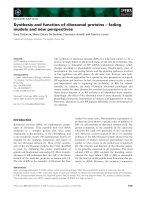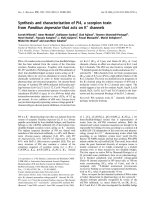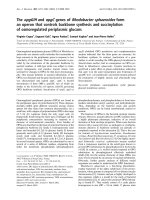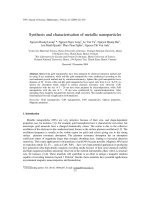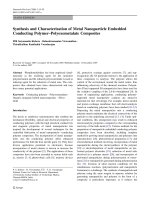design, synthesis and photophysics of fluorescence turn-on conjugated polymer chemosensors
Bạn đang xem bản rút gọn của tài liệu. Xem và tải ngay bản đầy đủ của tài liệu tại đây (3.47 MB, 182 trang )
DESIGN, SYNTHESIS AND PHOTOPHYSICS OF FLUORESCENCE
“TURN-ON” CONJUGATED POLYMER CHEMOSENSORS
BY
LI-JUAN FAN
B.S. Nanjing University, 1994
M.S. Fudan University, 1997
DISSERTATION
Submitted in partial fulfillment of the requirements for
the degree of Doctor of Philosophy in Chemistry
in the Graduate School of
Binghamton University
State University of New York
2006
UMI Number: 3214759
3214759
2006
UMI Microform
Copyright
All rights reserved. This microform edition is protected against
unauthorized copying under Title 17, United States Code.
ProQuest Information and Learning Company
300 North Zeeb Road
P.O. Box 1346
Ann Arbor, MI 48106-1346
by ProQuest Information and Learning Company.
© Copyright by Li-Juan Fan 2006
All Rights Reserved
Accepted in partial fulfillment of the requirements for
the degree of Doctor of Philosophy in Chemistry
in the Graduate School of
Binghamton University
State University of New York
2006
Wayne E. Jones, Jr.___________________________________________ April 27, 2006
Advisor, Chemistry Department
Susan L. Bane_______________________________________________ April 27, 2006
Chair, Chemistry Department
Alistair J. Lees_______________________________________________ April 27, 2006
Chemistry Department
Mark D. Poliks_______________________________________________ April 27, 2006
Chemistry Department
Susannah Gal________________________________________________ April 27, 2006
Outside Examiner, Department of Biological Sciences
iii
ABSTRACT
This dissertation explores the synthesis, characterization, and application of
conjugated polymers as fluorescence “turn-on” chemosensors. A series of conjugated
polymers using the poly[p-(phenyleneethynelene)-alt-(thienylene-ethylene)](PPETE)
polymer backbone were prepared using N,N-diethylamino (dea) and N,N,N’-
trimethylethylenediamino (tmeda) groups as receptors. The conjugated polymers were
designed as fluorescence “turn-on” chemosensors based on a photoinduced electron
transfer (PET) mechanism in which the polymer fluorescence is quenched in the absence
of coordinating analytes. A chelation-enhanced fluorescence (CHEF) phenomenon results
upon coordination of a cation to the redox active receptor as a result of termination of the
fluorophore quenching process. The polymers were fully characterizated by NMR, FTIR,
Gel Permeation Chromatography (GPC) and elemental analysis.
Detailed photophysical studies of dea-PPETE and tmeda-PPETE demonstrated
relatively weak emission at
λ
max
= 488 nm with quantum yields of 0.11 and 0.09. Room
temperature emission studies show that tmeda-PPETE exhibited a fluorescence “turn-on”
response in the presence of many cations at less than 500 nM concentrations. For
example, Hg
2+
in aqueous solution causes the fluorescence of tmeda-PPETE to increase
by a factor of 2.7 at less than millimolar concentrations. This represents the first example
of a conjugated polymer applied as a fluorescence “turn-on” chemosensor based on the
PET mechanism.
The competitive role of PET and energy migration is critical to sensor function.
This was investigated by synthesizing a series of PPETE’s with different amino receptor
iv
loadings. Theoretical and experimental studies revealed that the limited sensitivity
achieved in this system may be attributed to relatively slow energy migration (<10
9
s
-1
)
along the polymer backbone relative to the emissive lifetime (∼10
-10
s).
A highly selective and sensitive sensory system towards iron cations in solution
was achieved by preparing a transition metal derivatized conjugated polymer based on
Cu
2+
quenching. By preloading Cu
2+
onto the receptor of tmeda-PPETE, fluorescence
enhancements of 150 fold were achieved in the presence of 10 micromolar of iron
cations . The combination of the conjugated polymer and metal cation created a selective
sensor and offers a new paradigm for further sensor design.
v
To my family
vi
ACKNOWLEGMENTS
My gratitude begins with my advisor, Dr. Wayne E. Jones, Jr., who gave me the
opportunity to explore in this interesting field freely. I appreciate his guidance,
encouragement and patience with me through the past several years. His unique way of
mentoring student has helped me to come to know how science truly works and like
science more than ever before. I have gained more confidence and achieved more
independence in doing research under his supervision. I also learned a great deal from
him in the way of thinking, solving problems and communicating with others in research
and teaching. His insight into science and friendly attitude towards students also made the
entire journey very fruitable and enjoyable. I also thank him for his support and
understanding in other aspects of life besides research.
I would also like to extend my thanks to my committee: Dr. Susan Bane, Dr.
Alistair Lees, Dr. Mark Poliks and Dr. Susannah Gal for taking the time to read my
dissertation, useful discussion and all other help throughout my graduate study in
Binghamton University. Dr Scott Handy should also be thanked for serving as the
committee member for my preliminary oral exam.
I appreciate Dr. Brendan Flynn and Professor
Emeritus, Dr. Stanley K. Madan for
devoting their precious time in reading and correcting this dissertation and all my
manuscripts before submitting to different journals. I benefited a lot for my writing from
Dr. Flynn’s sharp and picky eyes as a teacher in reading my writing. Dr. Mandan’s
discussion about coordination chemistry and other aspects of life seems also became a
part of my everyday life in the past several years.
vii
I also thank Dr. Mark Poliks and Dr. Barbara Poliks to be my mentors and also
friends during the past several years. I got to know Dr. Mark Poliks in his polymer and
NMR class. I was impressed by his excellent teaching skill, broad knowledge and great
responsibility towards students. I also thank him for the instruction in the NMR project
related to my research. Dr. Barbara Poliks is such a warm-hearted lady and I really
enjoyed the discussion with her about many things. I feel very lucky they are always
there for me whenever I needed help and the help was always given very timely.
I would like to give my special thanks to my dear friends, Dr. Yan Zhang and Dr.
Zhengtao Zhu. They brought me here and through them I got to know where Binghamton
University was and also the Jones group. I am grateful that they assisted me to settle
down, allowed me to be their “dependent” for the first year I was here and for continuous
support even after they left.
I have so many friends and colleagues in the Chemistry Department that have
made this journey enjoyable. First, I wish to thank the whole Jones group, including
previous and current members. Dr. Biwang Jiang, who started this conjugated polymer
project, came to my poster at ACS meeting in New York City and then became my friend.
I was surprised that he still had many good suggestions about my research after so many
years away from our group. Dr. Szu-wei (Steve) Yang, who graduated in the first year I
joined the group, still was around and willing to provide help whenever I asked for. Dr.
Yan Zhang helped me to start the synthesis and Dr. Cliff Murphy helped me to start the
photophysics studies. Dr. Dave Sarno helped me to get familiar with the lab during the
first summer research. Dr. Cliff Timpson helped me with my E-Chem experiments during
his stay here for the sabbatical semester. Special thanks owe to Justin Martin, a really
viii
smart guy, who was my computer specialist and consultant for the past several years and
also brought a lot of laughter to our lab. Thanks also should be given to Dr. Hong Dong
to be my Chinese-Speaking partner in the lab. I’d like to thank all other members in our
group, namely, Dr. Ed Fey, Fredrick Ochanda, Jasper Chiguma, Wenlong Gui, Sarah
Angell, Matt Parker, Kat Minerly and many undergraduate students in our lab. Thank
you all for helping me with the research and all other fun we had in the lab besides the
research.
Some other people outside our group must be thanked for helping with my
research. I would like thank Dr. Yanan Zhang for acting as my organic synthesis
consultant; Dr. Jürgen Schulte for helping me with the NMR; Dr. Tatini Radhakrishna
for
helping me with the GPC; Dr.
Nikolay Dimitrov for discussion about E-Chem; Dr Robert
Ben and Dr. Scott Handy for discussion about some synthesis when they were still in the
department; Dr.
David Doetschman and Dr. Steve Yang for the EPR experiment and
related discussion. Dr. Tom Troxler at the University of Pennsylvania must also be
thanked for running all the lifetime experiments for us.
Many people in the chemistry department must be thanked for their support
besides research, such as Richard Quest, Dr. Bob Kematic, Dr. Alexa Silva, Mary Bridge ,
Renee Sersen, Pat Gorman, Linda Schaffer, Bob Gonzales, Dat Tran, Daniel Brennan.
Elizabeth Brown in the Science Library should also be thanked for her assist in literature
searching.
I also want to thank all the Chinese people in the Chemistry Department besides I
already mentioned above, Namely, Chunmei Ban, Chen Chen, Quan Fan, Dr. Xiaojuan
Fan, Li Han, Yan Lin, Shuhuai Liu, Dr. Jin Luo, Dr. Yanning Song, Jie Xiao, Linyan
ix
Wang, Dr. C. J. Zhong, et al. I also like to thank many other Chinese people outside our
department or even outside the university, such as Lin Tan, Yuanyuan Song, Jie Zhou
and Yuening Li couple, Carol Tang, Xueping and George Lee couple, and so on. We
enjoyed Chinese food together, celebrated our traditional Chinese holidays or non-
Chinese holidays and shared many other things together. Their companionship has made
me less homesick and my staying here more enjoyable.
I dedicate this dissertation to my father. He was so happy when I started this
journey. However, he was unable to wait until I finished it. I believe if there really is a
heaven, he must be looking down there, smiling at me as he used to. I am very proud of
my mother. She is still being so strong though experienced so many problems during the
past several years. I also thank her for taking care of my daughter. All the people in my
family and family-in-law must be appreciated for taking care of my daughter when I was
not around her.
The last but the most important people I must thank are my husband, Zhigang (Louis)
Lu and my daughter Minyuan (Betty) Lu. I feel so grateful to my husband for his love,
support and understanding for so many years. I also thank my daughter. She is so cute
and brought me so much fun, whether I was with her or not with her. Though I was
physically away from them most of time for the past four and half years, we kept in touch
with each other every day and shared details of our everyday life. We feel like we were
together all the time.I really thank them for giving me a home, both in reality and in spirit.
Finally, this work was funded by the National Institute of Health (Grant No.
1R15-ES10601-01) and Research Foundation of the State University of New York at
Binghamton.
x
TABLE OF CONTENTS
LIST OF TABLES
LIST OF FIGURES
LIST OF SCHEMES
LIST OF SYMBOLS AND ABBREVIATIONS
Chapter 1
Introduction to Fluorescent Chemosensors
1
1.1 Introduction to Sensors 1
1.2 Fluorescent Chemosensors 4
1.2.1 Photoinduced Electron Transfer 4
1.2.2 Electronic Energy Transfer 6
1.3 Conjugated Polymer as Fluorescence Chemosensor 8
1.4 Fluorescence “Turn-off” Sensor for Transitional Metals 13
1.5 Fluorescence “Turn-on” Sensors 15
1.5.1 Small Molecular “Turn-on” Sensors 15
1.5.2 Examples Polymer “Turn-on” Sensors 20
1.6 Dissertation Overview 24
1.7 References 27
Chapter 2
Synthesis and Characterization of Poly(p-phenyleneethylene)-
alt-(thienyleneethylene) with Amino Pendant Groups
32
2.1 Introduction 32
2.2 Experimental Section 34
2.3 Results and Discussion 40
2.3.1 Synthesis and Characterization 40
xi
Sonogashira coupling
40
Synthesis of monomers
43
Synthesis of polymers
48
2.3.2 Photophysics 54
2.3.3 Cation Titration 56
2.4 Conclusion 60
2.5 References 61
Chapter 3
Photoinduced Electron Transfer and Energy Migration in
PPETEs with Varying Receptor Loading
64
3.1 Introduction 64
3.2 Experimental Section 67
3.3 Results and Discussion 70
3.3.1 Synthesis and Characterization 70
3.3.2 Polymer Photophysics 75
3.3.3 Photoinuduced Electron Transfer 79
3.3.4 Energy Migration 81
3.3.5 Evaluation of (x%-tmeda)-PPETEs as
Fluorescence “Turn-on” Sensors
85
Ideal polymer system for fluorescence “turn-on”
PET sensors
85
Cation titration
88
3.4 Conclusion 93
3.5 References 94
xii
Chapter 4
A Highly Selective and Sensitive Inorganic/Organic Hybrid
polymer Fluorescence as “Turn-on” Chemosensor for Iron
Cations
98
4.1 Introduction 98
4.2 Experimental Section 100
4.3 Results and Discussion 102
4.3.1 Exceptional Copper (II) Quenching of tmeda-
PPETE
102
4.3.2 Fluorescence Enhancement with Iron (II) 108
4.3.3 High Selectivity toward Iron Cations 111
4.3.4 Mechanism for the Selectivity 118
4.3.5 Direct Observation of Binding by EPR 121
4.4 Conclusion and Future Work 125
4.5 References 126
Chapter 5
Synthesis of Building Blocks of Conjugated Polymers for
Sensor Applications
129
5.1 Introduction 129
5.2 Experimental Section 131
5.3 Results and Discussion 135
5.3.1 Polymer Backbone Changes 135
5.3.2 Sensor for Carbonyl Compounds 140
5.3.3 Anion Sensor 149
5.4 Conclusion 151
5.5 References 152
Chapter 6
Dissertation Overview and Prospects for the Future 154
xiii
LIST OF TABLES
Table 1-1. Summary of examples of fluorescence chemosensors discussed in
Chapter 1
24
Table 2-1
Molecular Weight and Polydispersity of dea-PPETE and tmeda-
PPETE
53
Table 2-2
Photophysical properties of PPETEs in THF solution at room
temperature
54
Table 2-3
Stepwise associate constants between some cations and ligands 58
Table 3-1
Theoretical and Measured Percentages of Nitrogen in (x%-tmeda)-
PPETE
74
Table 3-2
Molecular Weight and Polydispersity of (x%- tmeda)-PPETE 74
Table 3-3
Photophysical properties of (x%-tmeda)-PPETEs in THF solution
at room temperature
76
Table 3-4
Fluorescence quenching in (x%-tmeda)-PPETEs 84
Table 3-5
Maximum fluorescence enhancement factor for (x%-tmeda)-
PPETEs upon titration of different cations
92
Table 4-1
Quantum yields tmeda-PPETE, model PPETE, and tmeda-
PPETE with Cu
2+
104
Table 4-2
Electronic configurations of related cations 111
Table 4-3
Calculated pH values of cations at two difference concentrations 119
Table 4-4
Hydrolysis equilibrium constants and solubility parameter
constants for cations
120
xiv
LIST OF FIGURES
Figure 1-1
Schematic illustration of a sensor. 2
Figure 1-2
Schematic illustrate for fluorescent chemosensor 4
Figure 1-3
Orbital energy diagrams for fluorescent “turn-off” PET sensors
before and after binding analyte
5
Figure1- 4
Orbital energy diagrams for fluorescence “turn-on” PET sensors
before and after binding analyte
6
Figure 1-5
Orbital energy diagrams for double exchange transfer between
the excited fluorophore to the analyte bound by receptor
7
Figure 1-6
Plot of log(k
ET
) versus distance, r, for both Dexter and Föster
energy transfer mechanism, absent any criteria other than
distance.
8
Figure 1-7
π-conjugation in conjugated polymers
9
Figure 1-8
Basic structures of several fluorescent conjugated polymers 10
Figure 1-9
Structures of several conjugated polymers as fluorescent sensors 11
Figure 1-10
Schematic representation of molecular wire approach to sensory
signal amplification.
12
Figure 1-11
Structure of PPETE polymers with oligo-pyridine pedants 14
Figure 1-12
Examples of small molecules as fluorescence “turn-on” sensor
with amino receptors
17
Figure 1-13
An example of small molecule sensor shows fluorescence “turn-
on” upon anions
18
Figure 1-14
Reaction of aldehyde and ketone with N-amino-N-(1-
hexylheptyl)perylene-3,4:9,10-tetracarboxylbisimide
18
xv
Figure 1-15
Examples of sensors with thiourea group and modified thiourea
group
19
Figure 1-16
Glucose PET sensors with boronic acid as the receptor 20
Figure 1-17
Structures of polymer as fluorescence “turn-on” sensors 21
Figure 1-18
Structure of a conjugated polymer showed fluorescence “turn-
on” upon trysin
22
Figure 1-19
Structure of the two polymer components for fabricating a
sensor sandwich
22
Figure 1-20
Structure of a conjugated polymer as fluorescence “turn-on”
chemosensor for anions
23
Figure 2-1
Orbital energy diagram for fluorescence “turn-on” PET sensors
with amino receptor before and after binding cation
33
Figure 2-2
Structures of PPETE polymers with pendant amino receptor 34
Figure 2-3
NMR spectra of 1,4-diethyl-2,5-didodecyloxybenzene ,2,5-
dibromo-thiophen-3-ylmethyldiethylamine and N-(2,5-dibromo-
thiophen-3-ylmethyl)-N,N,N'-trimethylethane-1,2-diamine.
47
Figure 2-4
FTIR of dea-PPETE and its monomers
50
Figure 2-5
FTIR of tmeda-PPETE and its monomers 50
Figure 2-6
NMR spectra of tmeda-PPETE and dea-PPETE. 51
Figure 2-7
Comparison of routine
13
C NMR and
13
C DEPT of dea-PPETE
52
Figure 2-8
2D Heteronuclear (C,H)-Correlated NMR of dea-PPETE 52
Figure 2-9
UV-Vis and emission spectra of model PPETE, dea-PPETE and
tmeda-PPETE in THF solution at room temperature.
55
Figure 2-10
Fluorescence enhancement of tmeda-PPETE in THF upon
addition of metal cations.
56
xvi
Figure 2-11
Fluorescence enhancement of dea-PPETE in THF upon addition
of metal cations.
57
Figure 2-12
Emission and UV-Vis spectra of tmeda-PPETE upon addition of
different concentration of Hg
2+
.
59
Figure 3-1
Structures of (x%-tmeda)-PPETEs 66
Figure 3-2
1
H NMR spectra of (x%-tmeda)-PPETEs 73
Figure 3-3
FTIR spectra of (x%-tmeda)-PPETE 73
Figure 3-4
Absorption and emission spectra of (x%-tmeda)-PPETEs in
THF
76
Figure 3-5
Quantum yields of fluorescence vs percent loading of amino
groups in (x%-tmeda)-PPETEs.
78
Figure 3-6
Representation of process leading to energy-migration enhanced
quenching with a PET mechanism along the conjugated polymer
backbone.
81
Figure 3-7
Quantum yield ratios between the model PPETE and (x%-
tmeda)-PPETE vs percent loading of amino group.
83
Figure 3-8
Schematic illustration of response with binding cations for
monoreceptor loaded and polyreceptor loaded conjugated
polymers
86
Figure 3-9
Fluorescence enhancement of (x%-PPETE) in THF upon
addition of metal cations.
90
Figure 3-10
Enlarged parts of I/I
0
vs cation concentration curves (Figure 3-8)
at low cation concentrations
91
Figure 4-1.
Structure of tmeda-PPETEs 98
Figure 4-2
Fluorescence quenching of tmeda-PPETE upon titration of Cu
2+
aqueous solution
103
Figure 4-3
UV-Vis spectra of tmeda-PPETE upon titration of Cu
2+
aqueous 103
xvii
solution
Figure 4-4
Fluorescence response following excitation at 408 nm from
tmeda-PPETE/Cu
2+
solutions upon addition of Fe
2+
aqueous
solution.
104
Figure 4-5
The UV-Vis spectra of titration of FeCl
2
aqueous solution into
tmeda-PPETE/ Cu
2+
hybrid system
105
Figure 4-6
Fluorescence response following excitation at 408 nm from
tmeda-PPETE solutions upon addition of Fe
2+
aqueous solution
107
Figure 4-7
Suggested mechanism (schematic diagram) of fluorescence
enhancement of tmeda-PPETE/Cu
2+
upon titration of Fe
2+
109
Figure 4-8
Emission spectra of tmeda-PPETE; tmeda-PPETE/Cu
2+
and
tmeda-PPETE/Cu
2+
system titrated by Ca
2+
, Zn
2+
, Ni
2+
and Mn
2+
.
109
Figure 4-9
Emission spectra of tmeda-PPETE; tmeda-PPETE/Cu
2+
(1:1) and
tmeda-PPETE/Cu
2+
system titrated by Fe
3+
, H
+
, Hg
2+
and Co
2+
.
110
Figure 4-10
Fluorescence intensity enhancements upon various cations in the
tmeda-PPETE/ Cu
2+
sensory system
110
Figure 4-11
Emission spectra of tmeda-PPETE and the
system titrated by
Ca
2+
, Zn
2+
, Ni
2+
and Mn
2+
112
Figure 4-12
Emission spectra of tmeda-PPETE and the
system titratred by
Fe
3+
, Hg
2+
, H
+
and Co
2+
113
Figure4-13
Fluorescence intensity enhancements in tmeda-PPETE THF
solution.
114
Figure 4-14
Fluorescence response of tmeda-PPETE/Cu
2+
(green) or tmeda-
PPETE (red) to various 10 µM cations in room temperature
solution.
116
Figure 4-15
EPR spectra of Cu
2+
/tmeda-PPETE and Cu
2+
/tmeda-PPETE
added by Fe
2+
.
117
Figure 4-16
EPR spectra of Cu
2+
, Fe
2+
and Fe
3+
without tmeda-PPETE. 118
xviii
Figure 4-17
Dexter (double-electron exchange) energy transfer between an
excited fluorophore and Cu
2+
119
Figure 4-18
Electron transfer between an excited fluorophore and Cu
2+
123
Figure 4-19
Room temperature and low temperature emission spectra for
model-PPETE, tmeda-PPETE and tmeda-PPETE/Cu
2+
124
Figure 5-1
Schematic diagram of the –(A-(B-X))
n
- component
chemosensory polymer system
130
Figure 5-2
Structure of compounds discussed in Chapter 5 131
Figure 5-3
NMR spectra of amino receptor loaded phenyl building blocks 138
Figure 5-4
Targeted polymer (a-PPETE) for carbonyl group sensor and the
sensing reaction.
140
Figure 5-5
FTIR spectra for the monomers and polymers discussed in
Section 5.3.2
146
Figure 5-6
NMR spectra for the monomers and polymers discussed in
Section 5.3.2
147
Figure 5-7
2D Heteronuclear (C,H)-Correlated (HETCOR) NMR of phth-
PPETE
148
Figure 5-8
Orbital energy diagram for PET sensors for anions 149
Figure 5-9
Schematic diagram of anion sensors with thiourea group 150
Figure 5-10
1
H NMR of 2, 5-dibromo-3-(phenyl-thioureidomethyl)
thiophene in CDCl
3
and DMSO
151
xix
LIST OF SCHEMES
Scheme 2-1
Mechanism of Sonogashira Coupling 41
Scheme 2-2
Polymerization for PAE polymers under Sonoghshira coupling
proctol
43
Scheme 2-3
Synthesis of 1,4-diethylnyl-2,5-didodecyloxybenzene 44
Scheme 2-4
Synthesis of receptor-loaded monomer 45
Scheme 2-5
Synthesis of conjugated polymers containing amino receptors 48
Scheme 3-1
The Synthetic Route of (x%-tmeda)-PPETEs with Different
Receptor Loading
70
Scheme 5-1
Synthesis of amino receptor loaded phenyl building blocks. 137
Scheme 5-2
Unsuccessful synthesis of dea-PPE and tmeda-PPE 139
Scheme 5-3
Synthesis of 2, 5-dibromo-thiophene-3-ylmethylamine 142
Scheme 5-4
Unsuccessful synthesis of a-PPETE 142
Scheme 5-5
Synthesis of phth-PPETE 144
Scheme 5-6
Unsuccessful synthesis of a-PPETE 144
Scheme 5-7
Synthesis of thiourea group loaded thienyl building block 150
xx
LIST OF SYMBOLS AND ABBREVIATIONS
ε
Extinction coefficient
Φ
Quantum yield
λ
wavelength
λ
max
Emission maximum wavelength
τ
lifetime
τ
0
Initial lifetime
µM Micromolar
a. u. arbitrary unit
bp 2,2’-bipyridine
CH
3
CN acetonitrile
CHEF Chelation-enhanced fluorescence
cm centimeter
cm
-1
wavenumber
dea N,N-diethylamino
DEPT Distortionless enhancement by polarization
DP Degree of Polymerization
EET Electronic Energy Transfer
EPA Environmental Protection Agency
EPR Electron paramagnetic resonance
F fluorophore
FE Fluorescence enhancement
FET Field-Effect Transistor
FTIR Fourier Transform Infra-Red
xxi
GPC Gel Permeation Chromatography
HETCOR Heteronuclear Correlation NMR spectroscopy
HOMO Highest occupied molecular orbital
I Intensity
I
0
Initial intensity
K Kelvin (temperature)
k
f
rate constant of fluorescence
k
nr
rate constant of non-radiative decay
k
PET
rate constant of photoinduced electron transfer
K
SV
Stern-Volmer constant(static)
LUMO Lowest unoccupied molecular orbital
M Molar concentration
mm millimeters
Mn Number-averaged molecular weight
Mw Weight-averaged molecular weight
mM Milli Molar
NIH National Institutes of Health
nM Nano Molar
NMR nuclear magnetic resonance
13
C NMR
Carbon nuclear magnetic resonance
1
H NMR proton nuclear magnetic resonance
PAE polymer(aryleneethylene)s
PET Photoinduced electron transfer
PMMA polymethylmethacrylate
PPE Polyphenylene ethynylene
xxii
PPETE Poly(phenylene ethynylene thienylene ethynylene)
PS Polystyrene
PT polythiophene
THF Tetrahydrofuran
TMSA Tetramethylsilylacetylene
Q Quencher
tmeda N,N,N’-trimethylethylenediamino
TMEDA N, N, N’, N’-tetreamethylenediamine
ttp tolyterpyridine
UV Ultra-violet
xxiii
Chapter 1
Introduction to Fluorescent Chemosensors
1.1 Introduction to Sensors
A sensor is defined by the Oxford English Dictionary as “a device that detects or
measures a physical property and records, indicates or otherwise responds to it”. A sensor
achieves this goal by responding to an external stimulus and converting it into a signal
which can be measured or recorded.
1-3
The stimulus could be physical quantities (such as
length, weight, temperature, pressure etc.), chemical analytes or reactions, or biological
components in the real world.
1-3
Sensors are everywhere in our life. We have at least five
sensors of our own: nose, tongue, ear, eye and skin. Smoke alarms, thermometers,
barometers, radar, pH paper or pH meter are also very common sensors.
Generally, a sensor contains three elements: a receptor element, a signal transducer
and a read-out mechanism (see Figure 1-1). The recognition element is known as the
receptor which is the key component of the sensor device that interacts directly with the
analyte. The receptor should have the ability to discriminate the stimulus of interest,
avoiding interferences from the environment. The transducer converts the energy from
1
![Tài liệu Báo cáo khoa học: Specific targeting of a DNA-alkylating reagent to mitochondria Synthesis and characterization of [4-((11aS)-7-methoxy-1,2,3,11a-tetrahydro-5H-pyrrolo[2,1-c][1,4]benzodiazepin-5-on-8-oxy)butyl]-triphenylphosphonium iodide doc](https://media.store123doc.com/images/document/14/br/vp/medium_vpv1392870032.jpg)

